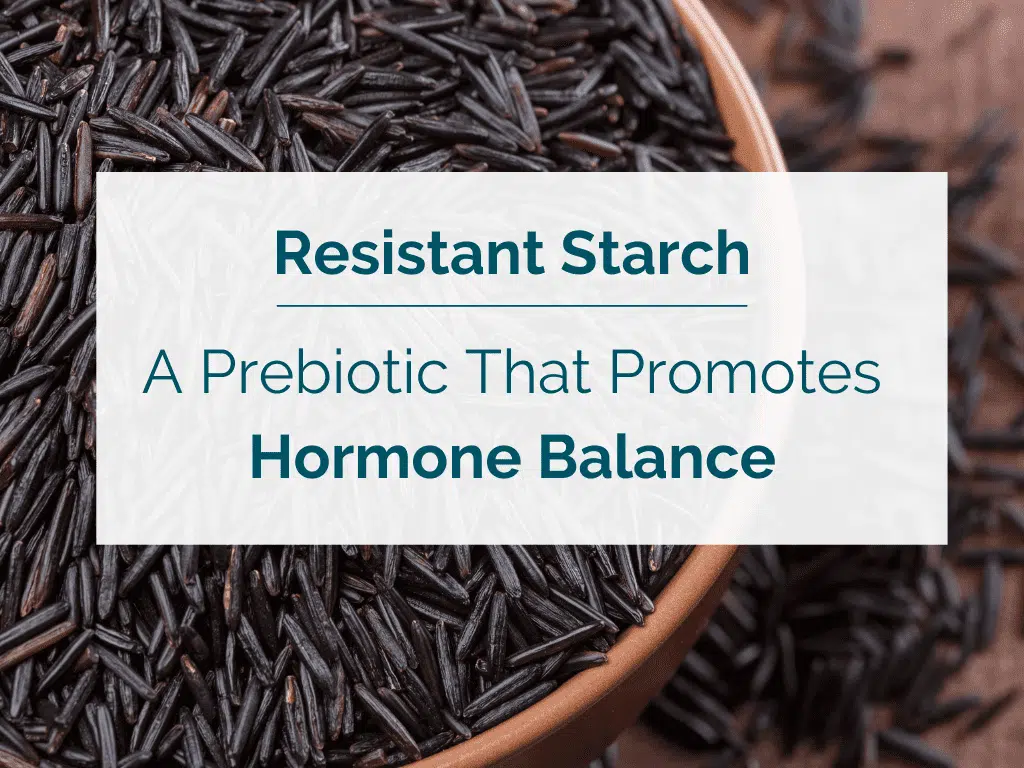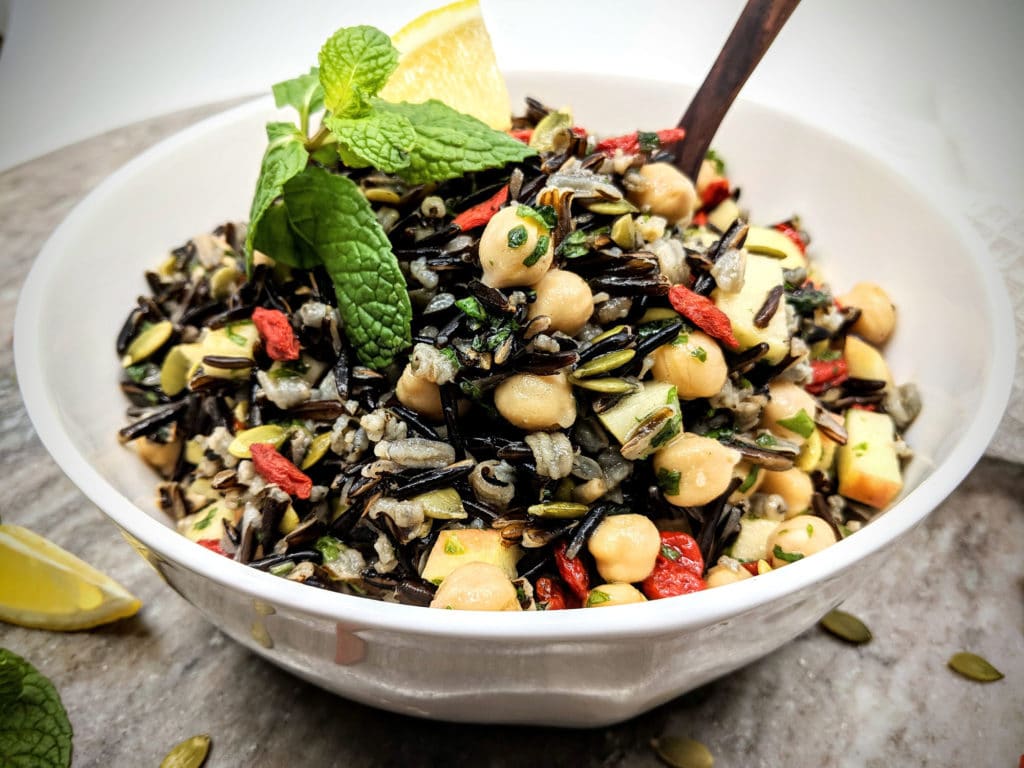
What You Will Learn in This Article
- The Role of the Gut in Hormonal Balance
- Benefits of Resistant Starch
- How to Add RS-Rich Food to your Diet
- RS Recipes
- The RS Supplement I Recommend
Resistant starch (RS) is a type of carbohydrate that our digestive enzymes cannot break down in the stomach or small intestine. They, therefore, reach the colon intact, “resisting” digestion.
This explains why we do not see spikes in either blood glucose or insulin after eating food rich in RS and why we do not obtain significant calories from RS.
I feel like RS is an overlooked area of repairing our gut. In my practice, more and more clients incorporate RS into their diets and get wonderful results—especially those struggling with digestive issues and a chronic case of candida overgrowth.
The key benefit is simple: RS is food for probiotics (whether you take them in the form of a pill or in food—I’m a proponent of doing both). In other words, it’s a prebiotic we often hear about. I’ve found the often cited prebiotics in the form of inulin, artichoke, etc. to be problematic for many people, especially those with IBS (irritable bowel syndrome) and leaky gut. It’s no surprise because many prebiotics are high on FODMAPs whereby food rich in RS is not.
The Role of the Gut in Hormonal Balance
Many people wonder why I go on and on about the health of our digestion when we struggle with hormonal issues. I completely understand—the connection may not be clear right away.
In short: there are three main reasons.
The first is that chronic digestive issues such as constipation, loose stools, bloating, acid reflux, and indigestion are perceived as stress, and additional cortisol (stress hormone) is produced to help deal with the digestive stress. When this is on top of all the other adversities many of us need to deal with on a daily basis, digestive issues can further worsen adrenal exhaustion.
The second reason is that 70% of serotonin is produced in the gut and serotonin has an upregulating function of other hormones including estrogen and progesterone (source).
The third and most recently discovered reason is the role of the estrobolome—a subset of gut bacteria that helps with the metabolism of estrogens, especially the dangerous estrogen metabolites responsible for breast, ovarian and thyroid cancers (source).
This is where RS comes in. Many of us already take probiotics and/or eat a cup of fermented foods daily to heal our digestion or to maintain good health. RS-rich food can further help by colonizing the gut with the good bacteria in a consistent and effective manner.
From my personal experience and the journey of many women I’ve worked with, I see faster healing happen when RS-rich foods are added. This applies to healing of the GI lining as well as clearing the body of candida (which 70% of women I work with suffer from).
To learn more about how to use food to rebalance your hormones, check out my book, Cooking for Hormone Balance, here.
Resistant Starch and Butyrate = Less Inflammation
One of the key benefits of RS is butyrate production which happens as a result of the fermentation in the gut.
Butyrate is the preferred energy source of the cells lining the colon and it also plays a number of roles in increasing metabolism, decreasing inflammation and improving stress resistance (source).
Butyrate is also a powerful anti-inflammatory agent for the colon and functions to improve the integrity of our gut by decreasing intestinal permeability and therefore keeping toxins in the gut and out of the bloodstream.
If you experience GI distress (such as discomfort, gas, and bloating) with even small amounts of RS, this may be an indication of SIBO (small intestinal bacterial overgrowth) or some other form of microbial dysbiosis.
I’ve done lots of research on this as there is contradictory and incomplete information out there and I’ve found Chris Kresser’s article to be comprehensive and well researched.
Here is the scoop, from his blog:
“There are four types of resistant starch:
RS Type 1: Starch is physically inaccessible, bound within the fibrous cell walls of plants. This is found in grains, seeds, and legumes.
RS Type 2: Starch with a high amylose content, which is indigestible in the raw state. This is found in potatoes, green (unripe) bananas, and plantains. Cooking these foods causes changes in the starch making it digestible to us, and removing the resistant starch.
RS Type 3: Also called retrograde RS since this type of RS forms after Type 1 or Type 2 RS is cooked and then cooled. These cooked and cooled foods can be reheated at low temperatures, less than 130 degrees and maintain the benefits of RS (6).
Heating at higher temperatures will again convert the starch into a form that is digestible to us rather than “feeding” our gut bacteria.
Examples include cooked and cooled parboiled rice, cooked and cooled potatoes, and cooked and cooled properly-prepared (soaked or sprouted) legumes.
RS Type 4: This is a synthetic form of RS that I’m including for completeness, but would not recommend. A common example is “hi-maize resistant starch.”
Benefits of Resistant Starch
1. Feeds “good” bacteria responsible for butyrate production. This applies to the bifido and lactobacillus bacteria which many people are deficient in. People who were not breastfed have a tendency to be low in bifidobacterium, so RS gives a wonderful opportunity to colonize your gut with the good guys.
2. Helps the estrobolome (a subset of bacteria that metabolize “dirty estrogens”)—hence potentially helping with estrogen dominance.
3. May preferentially bind to and expel “bad” bacteria—this explains why people with Candida do very well on RS.
4. Improves insulin sensitivity—this is especially important for women with sugar fluctuations and PCOS (but not only).
5. Improves the integrity and function of the gut.
6. Reduces fasting blood sugar. This is one of the most commonly mentioned benefits of RS, and the research seems to back it up.
7. Increases satiety.
What About Potatoes as Nightshades and Beans?
Yes, nightshades can be a problem for some people, especially those with rheumatoid arthritis and chronic body pains and aches. I have found that many people who can’t eat potatoes, do not react to the unmodified potato starch. I would, therefore, encourage you to try it. As always, go slow when introducing any new food, starting with ¼ of a teaspoon before you build it up.
I am reluctant to recommend beans and legumes. When cooked, they contain RS as well but I find that most people are having lots of difficulties digesting them, even when soaked and sprouted.
How to Add RS-Rich Food to your Diet
Here are a few of my recommendations:
- Green plantain flour. Since it can’t be heated in order to retain RS, the easiest thing to do is to add it to your morning smoothie. Its “chalky” texture might feel a little strange when dissolved in water but it blends really well into a smoothie.
- Cold potato salad. See my prebiotic potato salad recipe that goes back to my Eastern European roots and also incorporates sauerkraut. So, a prebiotic and a probiotic in one meal.
- Rice salads. Any cold rice salad would be a good addition. Cold sushi will also do the trick.
Unfortunately, I’ve found that plantains cannot be heated and cooled to get the same RS effect as potatoes, rice, and beans. Bummer.
As always, start adding RS-rich food slowly and build up.
RS Recipes
Prebiotic Rich Wild Rice Protein Salad
Not only is wild rice an excellent source of RS, but it is also very high in protein. We combine red apple, chickpeas, pumpkin seeds, goji berries, and fresh mint to create a beautiful dish that satisfies all the senses. It is refreshing, wholesome, and filling.
The green banana flour in these no-bake cookies makes them prebiotic. These cookies are simple, delicious, and low in sugar.
To learn more about how to balance your hormones with supplements (and which to take), you can download our FREE Supplement Guide here.


Loved the potato salad!!! Don’t wait to try the plantains now…
Great! ~HB Team
Loved the article on resistant starch. I wanted to add that green banana flour is an excellent resistant starch, also.
Yes, we agree! ~Deanna HB Team
Thanks Linda – that is another wonderful option:-)
Warmly,
Lisa
Customer Support
I recently read that tiger nut flour/powder is a good prebiotic. True?
Yes, Lea!
I tested tiger nut flour and it contained very little resistant starch.
I live in Australia and we have a local company , Natural Evolution, who grow and produce RS from Lady Finger bananas, that have the highest amount of nutritional value and the best form of RS in the world . I put a heaped tablespoon in my breakfast smoothie and it is such an easy way to get my daily dose of RS.
Thanks for mentioning as I live in WA. Just ordered!!
Yes, Natural Evolution has a good product, but their rhetoric about Lady Finger bananas is a marketing pitch. Nubana Green Banana Flour, available in the US but also in Australia, has more resistant starch and polyphenolic antioxidants besides! It is made with Cavendish bananas from South America. Any and all resistant banana starch is good, but always keep a look out for verifiable data.
I think the Nubana product is a flour only option which is designed for baking/cooking. Natural Evolution also have a flour option but also the Resistant Starch supplement which is a higher quality product for use in drinks, smoothies etc It has larger amounts of vitamins and minerals than the flour version. I can’t get the Nubana product where I live so have only used the Natural Evolution which seems to be very good – takes a few days for the digestion to get used to it but then everything settles down. Definitely start with small amounts and build up slowly!
Thanks for the article, very interesting.
Great article! How about use of heated then cooled sweet potatoes for those who can’t tolerate white potatoes due to RA etc?
Sure, that would work:) ~ Jeanne HB Team
[…] evacuating metabolized or “dirty” estrogens and prevents estrogen dominance. Some types of resistant starch qualify as insoluble […]
[…] large intestine (colon). Resistant Starch helps you naturally balance hormones – to learn why, check out my post on what it does and how it can boost your thyroid […]
I found a source for green banana flour. It says it has 17 carbs and no fiber. Are resistant starches not fiber? Do you know how it effects one who must eat super low carb?
[…] and imbalanced. To rebalance the immune system, it’s important to address the microbiome. Resistant starch can help restore your microbiome, balance your hormones, and lower your […]